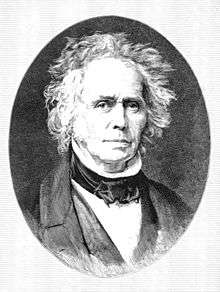William Cranch Bond
William Cranch Bond (9 September 1789 – 29 January 1859) was an American astronomer, and the first director of Harvard College Observatory.
William Cranch Bond | |
|---|---|
 William Cranch Bond | |
| Born | 9 September 1789 |
| Died | 29 January 1859 (aged 69) |
| Nationality | United States |
| Known for | Hyperion |
| Scientific career | |
| Fields | astronomy |
| Institutions | Harvard College Observatory |
Upbringing
William Cranch Bond was born in Falmouth, Maine (near Portland) on September 9, 1789. When he was young, his father, William Bond, established himself as a clockmaker after a failed business venture; trained by his father and aided by his penchant for engineering, W. C. Bond built his first clock when he was fifteen years old. He eventually took over his father’s business, becoming an expert clockmaker himself. The William Bond clock shop remained in existence at 9 Park Street in Boston until the 1970s..
Amateur astronomer
In 1806, when he was seventeen years old, Bond saw a solar eclipse. Soon thereafter, he became an avid amateur astronomer. When he built his first house, Bond made its parlor an observatory, complete with an opening in the ceiling out of which his telescope could view the sky.
Trip to Europe
In 1815, Bond traveled to Europe, commissioned by Harvard University to gather information on European observatories. On 18 July 1819 at Kingsbridge in Devon, England, Bond married his first cousin, Selina Cranch, who bore him four sons and two daughters. After Selina's death in 1831, Bond married her older sister, Mary Roope Cranch. He was elected a Fellow of the American Academy of Arts and Sciences in 1832.[1]
Harvard Observatory
In 1839, Bond was allowed to move his personal astronomical equipment to Harvard and serve as its (unpaid) "Astronomical Observer to the University." Later, in 1843, a sun-grazing comet aroused enough public interest in astronomy that Harvard was able to raise $25,730 towards the construction of a state-of-the-art observatory. Bond designed the building and the observing chair (both of which are still in working order today), and Harvard bought a fifteen-inch German-built refracting telescope, equal in size to the largest in the world at the time. The telescope was first put to use on June 24, 1847, when it was pointed at the moon.
Discoveries
- Independently discovered the Great Comet of 1811
- Bond and his son George Phillips Bond discovered Saturn's moon Hyperion; it was independently co-discovered at the same time by William Lassell in Britain, and both are given credit.
- Father and son were the first to observe the then innermost ring of Saturn, termed the Crepe ring, when they pointed Harvard’s telescope towards Saturn in 1850.
- Working with John Adams Whipple, the Bonds pioneered astrophotography, taking the first daguerreotype image of a star (Vega, in 1850) ever taken from America. In all, the three took between 200 and 300 photos of celestial objects.
Legacy
A number of celestial objects have been named in Bond's honor. A few of them include:
- The crater W. Bond on the Moon is named after him.
- A region on Hyperion is called the "Bond-Lassell Dorsum"
- Asteroid (767) Bondia is jointly named after him and his son.
- The Bond Gap within Saturn's C Ring is jointly named after him and his son.
External links
References
- "Book of Members, 1780–2010: Chapter B" (PDF). American Academy of Arts and Sciences. Retrieved September 13, 2016.
- Harvard's site on Bond and their observatory
- Gillespie, Charles Couston, editor-in-chief. Dictionary of Scientific Biography, vol 2. (New York: Charles Scribner's Sons, 1970–80, ISBN 0-684-80588-X)